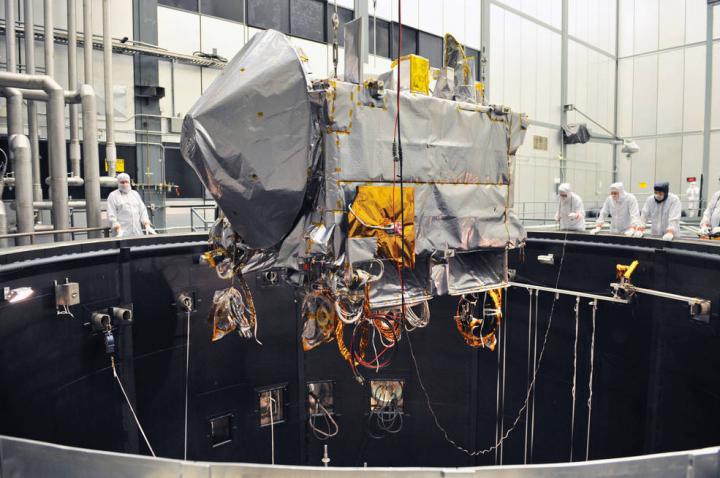NASA's OSIRIS-REx spacecraft in thermal vacuum testing

This is the OSIRIS-REx spacecraft being lifted into the thermal vacuum chamber at Lockheed Martin for environmental testing. Credits: Lockheed Martin
NASA's Origins, Spectral Interpretation, Resource Identification, Security-Regolith Explorer (OSIRIS-REx) spacecraft is in thermal vacuum testing, designed to simulate the harsh environment of space and see how the spacecraft and its instruments operate under 'flight-like' conditions.
OSIRIS-REx is scheduled to launch in September and travel to the asteroid Bennu to collect a sample and return it to Earth for study.
Scientists expect Bennu may hold clues to the origin of the solar system and the source of the water and organic molecules that may have made their way to Earth.
On Feb. 11, the orbiter was lifted into a 65-foot-tall thermal vacuum chamber at Lockheed Martin's facility near Denver, Colorado.
OSIRIS-REx will be powered on and off while being in a vacuum and exposed to extreme cold and heat that it will see over its seven-year mission to Bennu. After the air has been removed from the chamber, liquid nitrogen is pumped into tubes that run throughout the wall of the chamber, bringing the temperature down to as low as minus 274 degrees Fahrenheit.
A powerful light is turned on periodically to simulate the sun and the heat the spacecraft will experience. Throughout the 22-day test, a team of engineers test and monitor the spacecraft and its instruments 24 hours a day.
NASA Goddard Space Flight Center in Greenbelt, Maryland provides overall mission management, systems engineering and safety and mission assurance for OSIRIS-REx. The University of Arizona, Tucson leads the science team and observation planning and processing.
Lockheed Martin Space Systems in Denver is building the spacecraft. OSIRIS-REx is the third mission in NASA's New Frontiers Program. NASA's Marshall Space Flight Center in Huntsville, Alabama, manages New Frontiers for the agency's Science Mission Directorate in Washington.
For more information about NASA's OSIRIS-REx mission, visit:
Media Contact
All latest news from the category: Physics and Astronomy
This area deals with the fundamental laws and building blocks of nature and how they interact, the properties and the behavior of matter, and research into space and time and their structures.
innovations-report provides in-depth reports and articles on subjects such as astrophysics, laser technologies, nuclear, quantum, particle and solid-state physics, nanotechnologies, planetary research and findings (Mars, Venus) and developments related to the Hubble Telescope.
Newest articles

A universal framework for spatial biology
SpatialData is a freely accessible tool to unify and integrate data from different omics technologies accounting for spatial information, which can provide holistic insights into health and disease. Biological processes…

How complex biological processes arise
A $20 million grant from the U.S. National Science Foundation (NSF) will support the establishment and operation of the National Synthesis Center for Emergence in the Molecular and Cellular Sciences (NCEMS) at…

Airborne single-photon lidar system achieves high-resolution 3D imaging
Compact, low-power system opens doors for photon-efficient drone and satellite-based environmental monitoring and mapping. Researchers have developed a compact and lightweight single-photon airborne lidar system that can acquire high-resolution 3D…





















